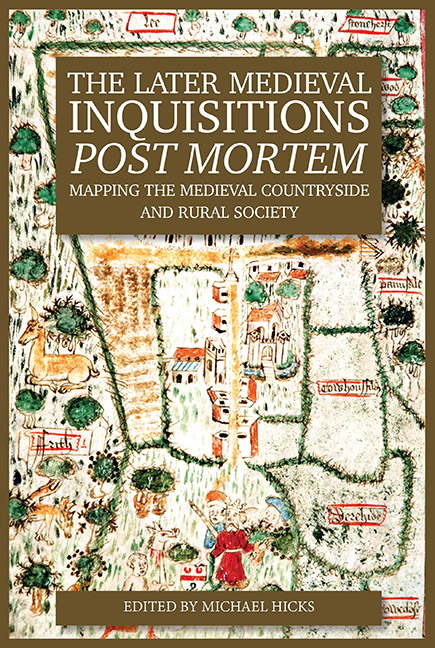Book contents
- Frontmatter
- Contents
- List of Illustrations
- List of Contributors
- Glossary
- List of Abbreviations
- 1 Introduction
- 2 Records of an Imperial Administration? Inquisitions Post Mortem in Scotland and Calais
- 3 Inquisitions Post Mortem in Medieval Ireland
- 4 The Court of the Honour of Clare, 1308–60: Feudal Incidents and Inquisitions
- 5 Landscape, Farming and Society in an English Region: The Inquisitions Post Mortem for the West Midlands, 1250–1509
- 6 Beyond the Dots: Mapping Meaning in the Later Medieval Landscape
- 7 Fairs and Markets in the Inquisitions Post Mortem
- 8 The Structure of the Milling Industry 1427–37
- 9 Proofs of Age 1246 to 1430: Their Nature, Veracity and Use as Sources
- 10 What Went On in the Medieval Parish Church, 1377–1447, with Particular Reference to Churching
- 11 Retainers, Monks and Wine: Three Insights into Everyday Life
- 12 The Administration and Efficiency of the Inquisitions Post Mortem Process: A Case Study of Northumberland
- 13 Late Medieval Land Disputes and the Manipulation of the Inquisitions Post Mortem
- Index
5 - Landscape, Farming and Society in an English Region: The Inquisitions Post Mortem for the West Midlands, 1250–1509
Published online by Cambridge University Press: 26 May 2021
- Frontmatter
- Contents
- List of Illustrations
- List of Contributors
- Glossary
- List of Abbreviations
- 1 Introduction
- 2 Records of an Imperial Administration? Inquisitions Post Mortem in Scotland and Calais
- 3 Inquisitions Post Mortem in Medieval Ireland
- 4 The Court of the Honour of Clare, 1308–60: Feudal Incidents and Inquisitions
- 5 Landscape, Farming and Society in an English Region: The Inquisitions Post Mortem for the West Midlands, 1250–1509
- 6 Beyond the Dots: Mapping Meaning in the Later Medieval Landscape
- 7 Fairs and Markets in the Inquisitions Post Mortem
- 8 The Structure of the Milling Industry 1427–37
- 9 Proofs of Age 1246 to 1430: Their Nature, Veracity and Use as Sources
- 10 What Went On in the Medieval Parish Church, 1377–1447, with Particular Reference to Churching
- 11 Retainers, Monks and Wine: Three Insights into Everyday Life
- 12 The Administration and Efficiency of the Inquisitions Post Mortem Process: A Case Study of Northumberland
- 13 Late Medieval Land Disputes and the Manipulation of the Inquisitions Post Mortem
- Index
Summary
Defining local differences in farming, land management and rural society is a great achievement of the historians working on the early modern period, and in particular Joan Thirsk. They were helped by the comments of the early modern antiquaries and topographers, who described the countryside in such terms as champion, woodland and wold, which we still find appropriate. The systematic and scientific study of land use and farming systems arises from the thousands of probate inventories, which covered the whole country using fairly standard formulae from the mid-sixteenth into the eighteenth centuries. These documents listed for each holding the acreages of crops and the numbers of all types of livestock, and historians could note the patterns of similarity and difference.
Historians of the later Middle Ages can carry out a similar exercise for the agricultural economy of lords’ demesnes by using manorial accounts compiled by reeves and bailiffs, but their geographical spread is rather restricted. They appear in abundance between about 1280 and 1380, and they become very scarce after about 1420. How can the extents attached to IPMs supplement the accounts in defining local varieties of land use and farming methods? They inform us about lay estates, whereas many of the accounts were made for church landlords, and consequently the extents cover some regions where accounts are scarce. Detailed extents were compiled over a long period, from the mid-thirteenth century into the sixteenth, so they are capable of reflecting long-term changes. They rarely say much about crops and animals, but they tell us more than the accounts about the various uses of land, and very occasionally they contain information about specific fields, pastures and woods. As with any source, they gain in value when they are combined with other documents.
This paper begins with questions about local variations in the use and organisation of land, and the social structure associated with different landscapes, based mainly on the IPMs of c.1250–1350. It then asks how land management changed through the 250 years covered by the extents attached to the inquisitions. It concentrates on the three West Midland counties of Gloucestershire, Warwickshire and Worcestershire, most of which lay within the diocese of Worcester, and which can be regarded as a coherent topographical unit coinciding roughly with the valley of the River Severn and its tributaries.
- Type
- Chapter
- Information
- The Later Medieval Inquisitions Post MortemMapping the Medieval Countryside and Rural Society, pp. 59 - 83Publisher: Boydell & BrewerPrint publication year: 2016
- 1
- Cited by

